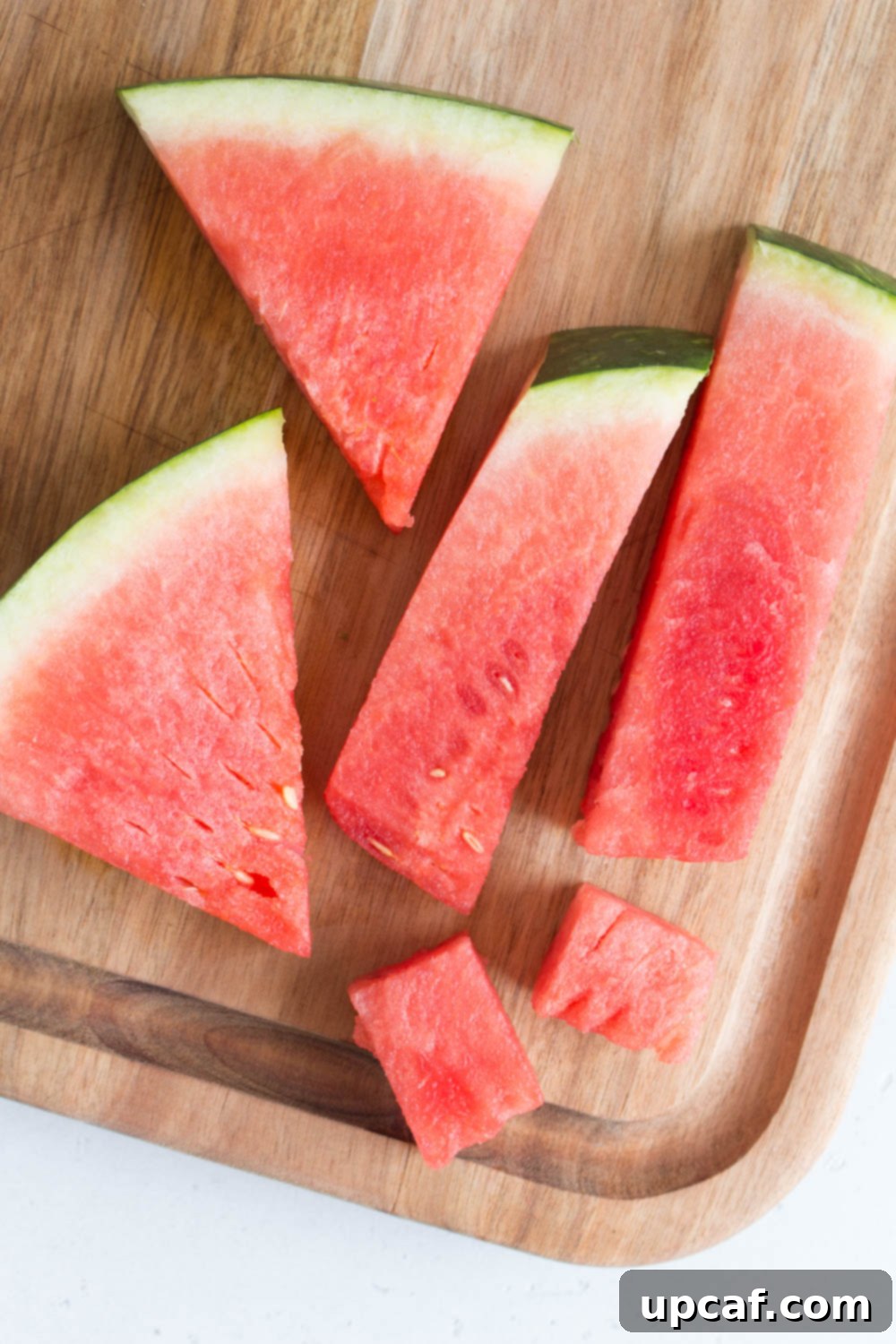Watermelon is the quintessential fruit of summer – incredibly refreshing, wonderfully sweet, and packed with hydrating goodness. However, its impressive size can often make the task of cutting a whole watermelon seem daunting. Many find themselves wondering where to begin or how to achieve those perfectly uniform wedges, cubes, or sticks that make for easy snacking and serving. Fear not! This comprehensive guide will demystify the process, showing you how to quickly and easily transform a whole watermelon into ready-to-eat pieces in minutes. Say goodbye to messy, uneven slices and hello to perfectly portioned watermelon, whether you’re preparing for a backyard BBQ, a healthy snack, or a vibrant fruit salad.
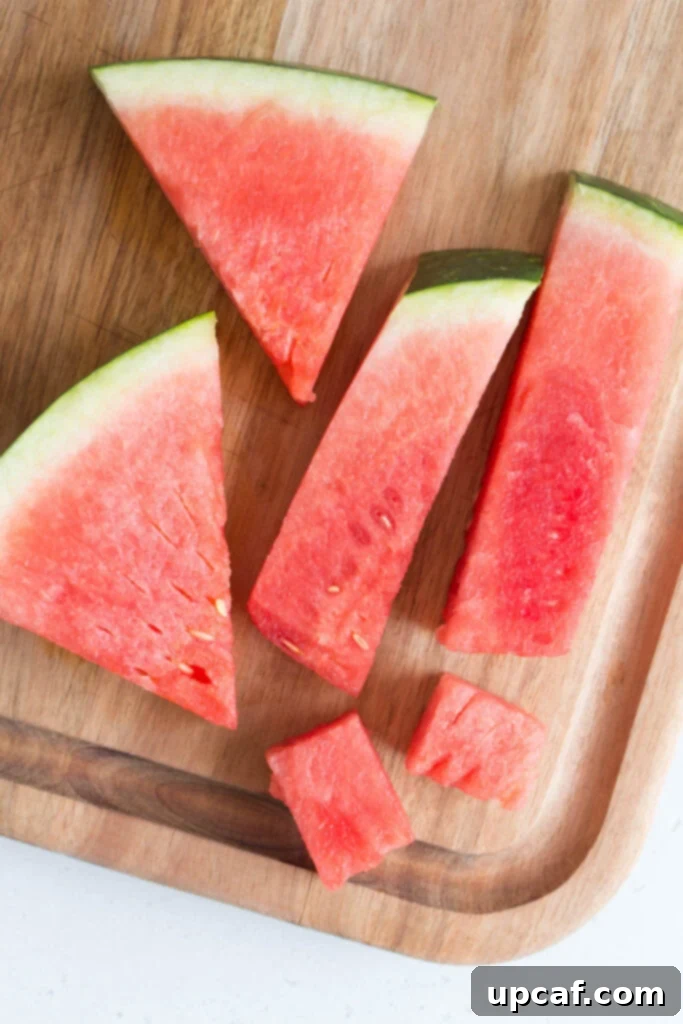
Why Watermelon Deserves a Spot on Your Plate: Health Benefits & Fun Facts
More than just a delicious treat, watermelon is a nutritional powerhouse, especially renowned for its exceptional hydrating properties. Comprising about 92% water, it’s an excellent choice for staying refreshed, particularly during warm weather or after physical activity. But its benefits extend far beyond hydration; this juicy fruit is brimming with essential vitamins, antioxidants, and amino acids.
Here’s a closer look at the impressive nutritional profile of watermelon:
- Vitamin A: Crucial for vision, immune function, and skin health.
- Vitamin B6: Supports brain health and helps convert food into energy.
- Vitamin C: A powerful antioxidant that boosts immunity and promotes collagen production.
- Lycopene: A potent antioxidant responsible for watermelon’s red color, linked to heart health and cancer prevention.
- Antioxidants: Beyond lycopene, watermelon contains other antioxidants that combat free radicals and reduce oxidative stress.
- Amino Acids: Including citrulline, which may improve athletic performance and reduce muscle soreness.
- Potassium: An important electrolyte that helps maintain fluid balance, nerve signals, and muscle contractions.
Incorporating watermelon into your diet is a simple and delicious way to support overall health and well-being. Its natural sweetness also makes it a fantastic, guilt-free alternative to processed sugary snacks.
Understanding Your Watermelon: Types and How to Choose the Best One
Before you even think about cutting, it’s helpful to know a little about the different types of watermelons available and, crucially, how to select a perfectly ripe one. A great watermelon experience starts with a great watermelon!
Popular Watermelon Varieties
Watermelons come in various shapes and sizes, each with its unique characteristics:
- Seeded Watermelon: This is the classic, traditional watermelon. Typically round or oval, these can range significantly in size, usually weighing between 15 and 45 pounds. They contain the familiar black, nutrient-rich seeds, which can be eaten or easily removed. Their flavor is often considered the most robust and sweet.
- Seedless Watermelon: Genetically bred to be seedless (though they may contain small, edible white remnants of undeveloped seeds), these watermelons offer convenience for many. They are similar in shape to seeded varieties but generally smaller, often weighing around 15 pounds. They retain the sweet, refreshing taste without the hassle of spitting out seeds.
- Miniature Watermelon: Also known as “icebox” watermelons, these smaller varieties are perfect for individual servings or smaller families. Examples include the popular Sugar Baby or Tiger Baby types. Round and compact, they typically weigh between 6 and 10 pounds and fit easily into a refrigerator. They are known for their intensely sweet flesh and thin rinds.
Master the Art of Selecting a Ripe Watermelon
Picking a ripe watermelon can feel like a secret art, but with these simple tips, you’ll be choosing perfect melons every time:
- The Heavier, The Better: Lift a few watermelons. You want one that feels surprisingly heavy for its size. This indicates a high water content and thus, a juicy, ripe fruit. A lighter watermelon for its size might be dry or underripe.
- Look for a Yellow Field Spot: This is arguably the most reliable indicator of ripeness. As watermelons grow and ripen on the ground, they develop a creamy yellow or orange-yellow patch where they rested. This “field spot” signifies that the melon was allowed to ripen fully on the vine. Avoid melons with white or green field spots, which indicate underripeness.
- Inspect the Skin: The skin should be dull, not shiny. A shiny watermelon usually indicates it’s underripe. It should also be firm to the touch, without any soft spots, bruises, or deep cuts, which could suggest internal damage or spoilage. Small “webbing” or brown lines on the rind are also a good sign, as they suggest bees visited the flower, leading to sweeter fruit.
- Give it a Knock: Gently tap the watermelon with your knuckles. A ripe watermelon should produce a deep, hollow sound. If it sounds dull, mushy, or too solid, it might be overripe or underripe. Practice this on a few melons, and you’ll quickly get a feel for the right sound.

Essential Tools for Cutting Watermelon
Having the right tools makes a significant difference in the ease and safety of cutting a watermelon. You’ll primarily need:
- A Large, Sharp Chef’s Knife or Serrated Knife: A long blade (at least 8-10 inches) is essential to cut through the thick rind. A sharp chef’s knife provides clean cuts, while a serrated knife can grip the waxy skin more easily. Choose whichever you feel most comfortable and confident using.
- A Sturdy Cutting Board: A large, non-slip cutting board is crucial. It needs to be big enough to comfortably hold half of the watermelon without it wobbling, ensuring stability and safety during cutting.
- A Large Bowl or Container: For collecting the cut watermelon pieces.
Step-by-Step Guide: How to Cut a Watermelon Like a Pro
Now for the main event! With a ripe watermelon and the right tools, you’re ready to master various cutting techniques. Remember to always work on a stable surface and use caution when handling sharp knives. Wash your watermelon thoroughly before cutting to remove any dirt or bacteria from the rind.
Method 1: Classic Watermelon Triangle Wedges
This method yields traditional, easy-to-handle wedges, perfect for picnics or simply biting into a refreshing slice.
- Step 1: Halve the Watermelon Widthwise. Place the watermelon on your cutting board. Using your large, sharp knife, carefully slice the watermelon in half across its width (the shorter dimension). This will give you two large, circular halves.

- Step 2: Quarter the Watermelon Lengthwise. Take one half of the watermelon and place it cut-side down on the cutting board for stability. Now, cut it in half again lengthwise, from one end to the other. Repeat with the other half, resulting in four equal quarters.
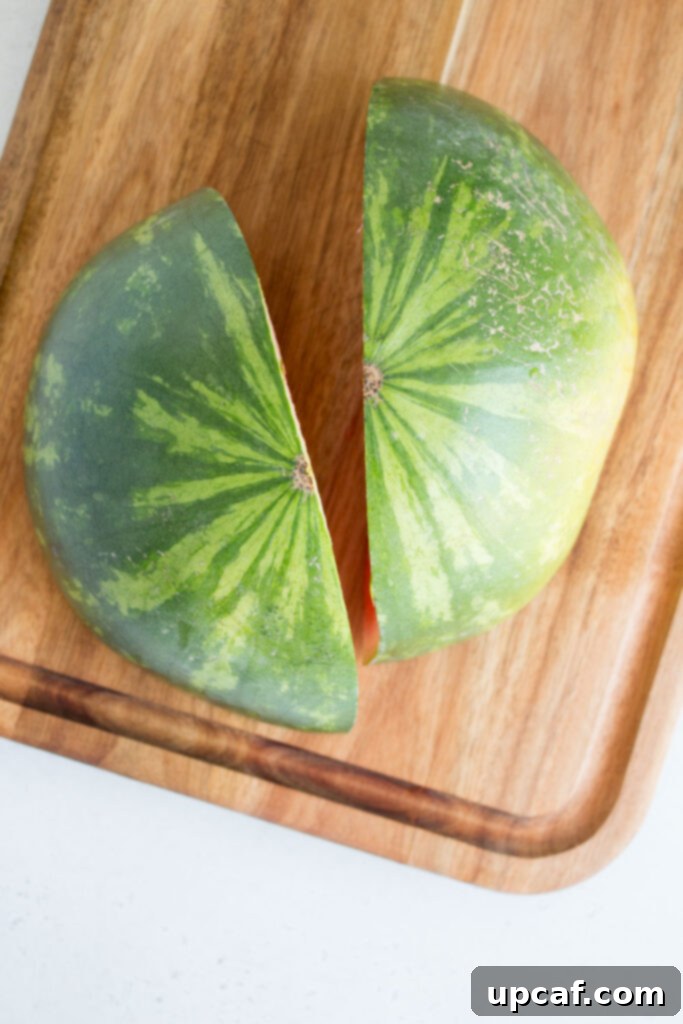
- Step 3: Slice into Wedges. Lay each quarter cut-side down. Now, slice each quarter into desired thickness, creating classic triangular wedges. You can make them thick and chunky or thinner for smaller hands. Repeat with all quarters until your watermelon is a pile of perfect wedges.
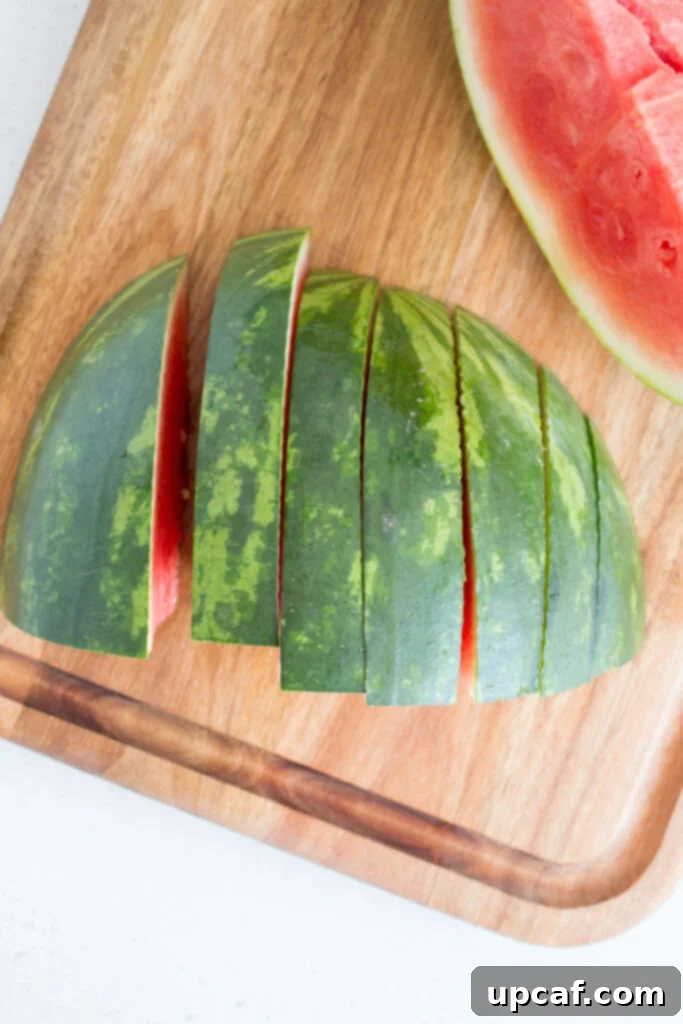

Method 2: Convenient Watermelon Sticks
Watermelon sticks are fantastic for snacking, especially for kids, as they are easy to hold and eat without making a mess. They also look great on a fruit platter.
- Step 1: Halve the Watermelon Widthwise. Just like with wedges, start by cutting the entire watermelon in half across its width.
- Step 2: Create a Grid Pattern. Place one of the watermelon halves cut-side down on your cutting board. This provides a stable base. Now, make parallel cuts horizontally across the melon, approximately 1-inch apart. Then, rotate the melon 90 degrees and make parallel vertical cuts, again about 1-inch apart. You’ll have a grid pattern on the melon.
- Step 3: Serve the Sticks. The rind acts as a natural holder. Simply push up from the bottom of the rind to pop out the watermelon sticks, or use your knife to run along the rind and release them onto a plate. The sticks should easily separate from each other.

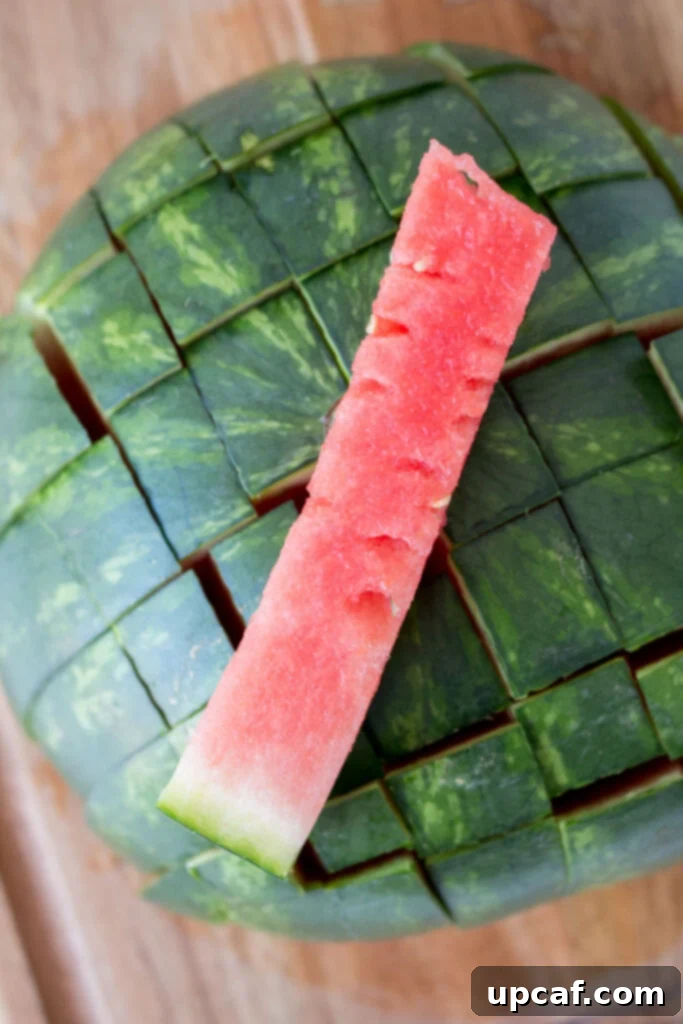

Method 3: Perfect Watermelon Cubes
Watermelon cubes are incredibly versatile, ideal for fruit salads, blending into smoothies, or simply enjoying with a fork. This method builds directly on the stick method.
- Step 1: Halve the Watermelon Widthwise. Begin by cutting the watermelon in half across its width.
- Step 2: Cut into Sticks (Grid Pattern). Place one of the watermelon halves cut-side down. Make horizontal and vertical cuts to create a grid pattern, just as you would for sticks. Ensure your cuts go almost all the way down to the rind but don’t cut through it initially.
- Step 3: Slice Off the Rind (Optional, but Recommended). Carefully run your knife along the inside edge of the rind, separating the entire grid of watermelon sticks from the skin. You can then place this large section of watermelon flesh on its side.
- Step 4: Cube the Sticks. Once you have the watermelon flesh in a solid block with a grid pattern, simply turn it on its side and cut across the sticks to create individual cubes. This is much faster and safer than cubing pieces while still attached to the rind. Gather your beautiful cubes into a bowl.

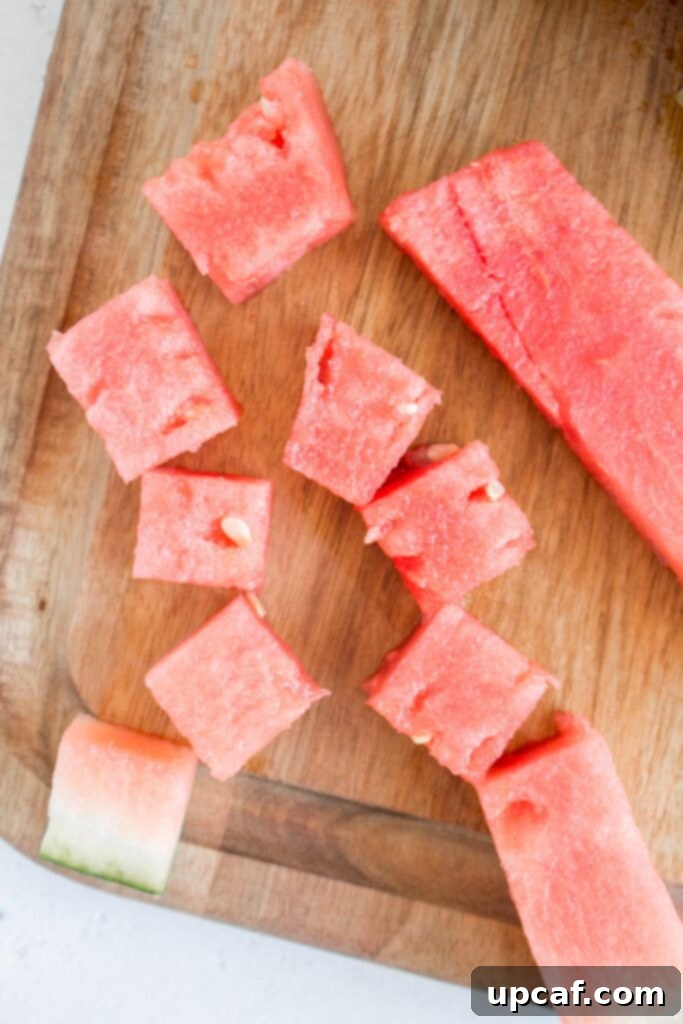
Maximizing Freshness: Storing Your Watermelon
Proper storage is key to enjoying your watermelon for as long as possible, whether it’s whole or freshly cut.
- Storing Cut Watermelon: Once you’ve cut your watermelon, its exposed flesh can dry out or absorb refrigerator odors. To keep it fresh, store any cut pieces (wedges, sticks, or cubes) in airtight containers in the refrigerator. This will help maintain its moisture, flavor, and prevent contamination. Properly stored, cut watermelon will stay fresh for 3-5 days. If you only cut a portion and have a half or a quarter remaining, tightly wrap the cut surface with plastic wrap before placing it in the fridge.
- Storing a Whole Watermelon: The ideal storage method for a whole, uncut watermelon depends on how it was originally sold.
- If you purchased your watermelon at room temperature (e.g., from a farmer’s market or a grocery store display outside the refrigerated section), it’s best to store it at room temperature in a cool, dark place. It will typically last about a week this way.
- If your watermelon was sold refrigerated, continue to store it in the fridge when you bring it home. This helps maintain its already cool temperature and extends its shelf life.
Whole watermelons generally last longer than cut ones, up to 2-3 weeks if stored correctly.

Freezing Watermelon: A Sweet Treat for Later
Did you know you can freeze watermelon? It’s a fantastic way to preserve excess fruit and have it on hand for smoothies or other refreshing treats, especially since a single watermelon can yield quite a lot!
To freeze watermelon effectively: start by cutting your watermelon into cubes. Arrange these cubes in a single layer on a baking sheet lined with parchment paper. This crucial step prevents the cubes from sticking together in one large frozen clump. Once they are frozen solid (usually after 2-3 hours), transfer the frozen cubes into a freezer-friendly airtight plastic bag (like a Ziploc) or a rigid container. Store them in the freezer for up to 3-4 months.
It’s important to note that frozen watermelon doesn’t defrost well for eating fresh slices due to a significant change in its texture – it becomes much softer and somewhat mushy. However, it’s absolutely perfect for use in frozen applications like smoothies, slushies, or homemade sorbets, where the texture change won’t be an issue and its icy coolness is an asset.
Watermelon Season & Yield Insights
Knowing when watermelon is at its prime can help you enjoy the best flavor and value.
- When is Watermelon in Season? Watermelon typically enjoys its peak season from May to September in North America. During these warmer months, it’s usually at its freshest, most flavorful, and tends to be significantly cheaper due to abundant supply. While available year-round in some regions, summer is undeniably the best time to indulge.
- How Many Cups of Watermelon are in a Pound? This is a common question for recipes! Generally, one pound of watermelon, once the rind is removed and the flesh is cut, yields approximately 1.5 cups of cubed watermelon. So, a 10-pound watermelon could give you around 15 cups of delicious fruit!
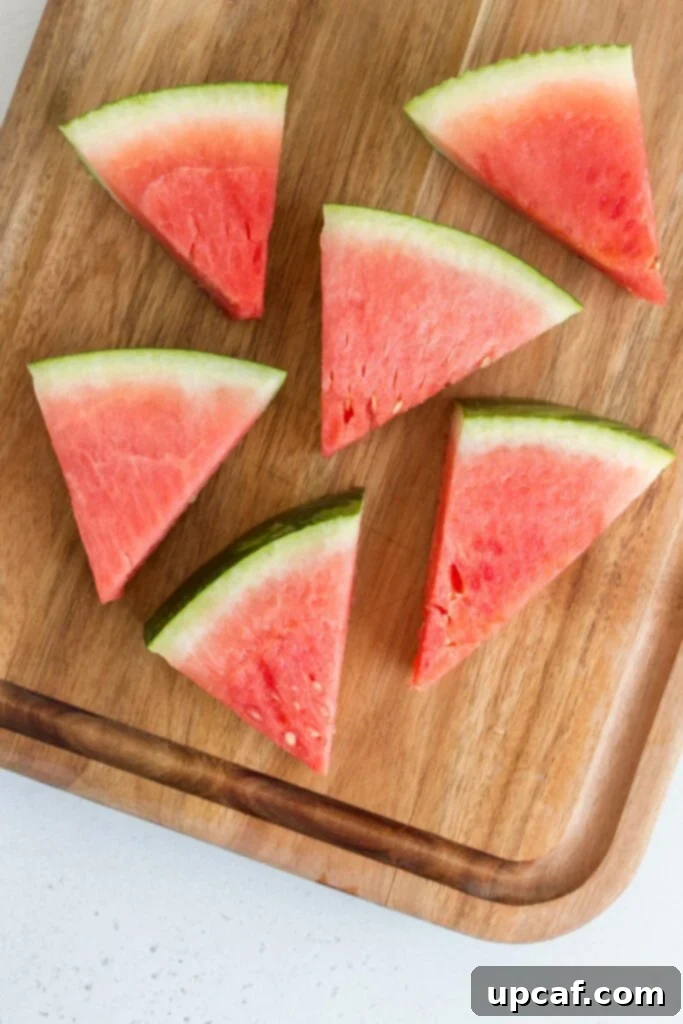
Beyond Fresh Slices: Creative Ways to Enjoy Watermelon
With an abundance of perfectly cut watermelon, you might be looking for ways to use it beyond just eating it plain. Here are some fantastic and refreshing ideas:
- Watermelon Salsa: Dice watermelon finely and combine with red onion, jalapeño, cilantro, and lime juice for a sweet and spicy salsa that pairs wonderfully with grilled fish, chicken, or tortilla chips.
- Watermelon Slushie: Blend frozen watermelon cubes with a splash of water or lime juice for an instant, incredibly refreshing, natural slushie – no added sugar needed!
- Watermelon Smoothie: Combine fresh or frozen watermelon with other fruits like berries or banana, yogurt, and a liquid of your choice for a nutritious and hydrating smoothie.
- Watermelon Salad: Create a vibrant salad by tossing watermelon cubes with feta cheese, fresh mint, and a drizzle of balsamic glaze. The sweet, salty, and savory flavors are an exquisite combination.
- Fruit Trays: Incorporate your beautifully cut watermelon wedges, sticks, or cubes into colorful fruit platters for parties or gatherings. They add a pop of color and freshness.
- Watermelon Sorbet: Blend fresh watermelon with a little lemon or lime juice and a touch of sweetener (optional), then churn in an ice cream maker for a light, summery sorbet.
Recipe: How to Cut a Watermelon
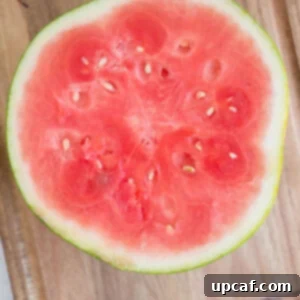
How to Cut a Watermelon
By: Mariam Ezzeddine
Not sure where to start when cutting a whole watermelon? Here’s how you can quickly and easily cut a whole watermelon into wedges, cubes, and sticks for easy eating!
Prep Time: 10 minutes
Total Time: 10 minutes
Servings: 6 servings
Ingredients
- ½ watermelon, ripe
Instructions
- How To Cut Watermelon Triangle Wedges: Cut the watermelon in half, widthwise then cut the watermelon in half again lengthwise. Next, cut each of those quarters into wedges, as thick or as thin as you’d like.
- How To Cut Watermelon Sticks: Cut the watermelon in half, widthwise. Place one half cut-side down and cut a grid pattern (horizontally and vertically) all the way through to the rind.
- How To Cut Watermelon Cubes: Cut the watermelon in half, widthwise. Place one half cut-side down and cut a grid (horizontally and vertically). Carefully run your knife along the rind to separate the flesh. Then, cut the watermelon sticks into cubes.
Nutrition
Calories: 113kcal | Carbohydrates: 28g | Protein: 2g | Fat: 1g | Saturated Fat: 0.1g | Polyunsaturated Fat: 0.2g | Monounsaturated Fat: 0.1g | Sodium: 4mg | Potassium: 420mg | Fiber: 2g | Sugar: 23g | Vitamin A: 2134IU | Vitamin C: 30mg | Calcium: 26mg | Iron: 1mg
Mastering the art of cutting a watermelon doesn’t just make for neater snacking; it unlocks a world of culinary possibilities. From quick, refreshing bites to innovative salads and frozen treats, a perfectly prepped watermelon is a versatile ingredient that embodies the spirit of summer. By following these simple steps, you’ll gain the confidence to tackle any whole watermelon, ensuring you can enjoy its sweet, hydrating goodness with minimal fuss and maximum enjoyment. So grab your knife, pick a ripe melon, and get ready to enjoy the ultimate summer fruit!
